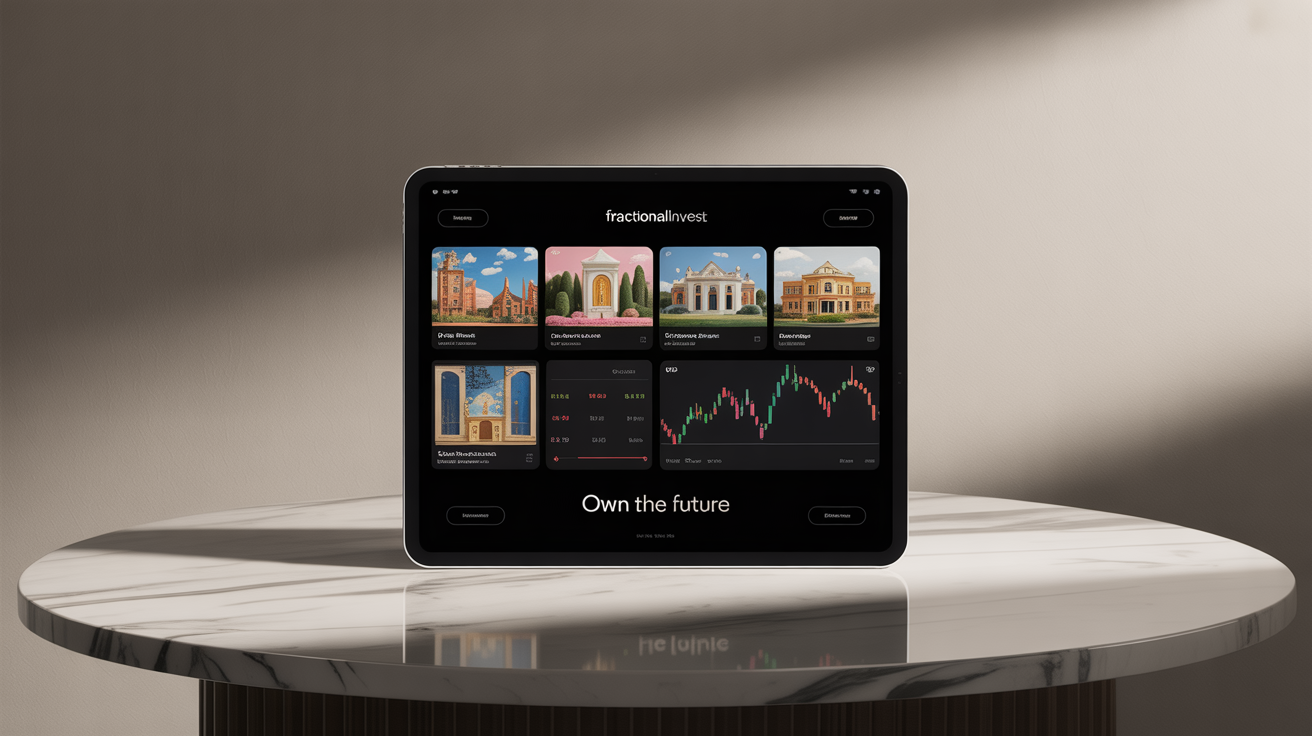Imagine owning a piece of a Picasso painting, a luxury Manhattan apartment, or shares in a booming tech startup—without needing millions in the bank. For many, the dream of investing in high-value assets like art, real estate, or stocks has felt out of reach due to high costs and exclusivity. Enter fractional investing, a game-changing approach that democratizes wealth-building by letting you own a slice of premium assets for as little as $10. This article explores the rise of fractional investing, how it works, its benefits, and why it’s reshaping wealth creation in 2025. Whether you’re a beginner investor or a seasoned pro, you’ll discover actionable insights to diversify your portfolio and tap into opportunities once reserved for the ultra-wealthy.
What Is Fractional Investing?
Fractional investing allows multiple investors to pool their money to purchase a share of a high-value asset, such as real estate, fine art, or company stocks. Instead of buying the entire asset, you own a fraction, proportional to your investment. This model lowers the entry barrier, making premium investments accessible to everyday people.
How Fractional Investing Works
- Asset Selection: Platforms identify high-value assets (e.g., a $1 million property or a rare painting).
- Tokenization or Division: The asset is divided into smaller shares, often through digital tokens or fractional ownership agreements.
- Investment: Investors buy shares via platforms, starting with small amounts ($10–$100).
- Returns: Investors earn profits through dividends, rental income, or asset appreciation, depending on the asset type.
- Liquidity: Some platforms allow trading of fractional shares, enhancing flexibility.
Related LSI Keywords: fractional ownership, tokenized assets, investment platforms, wealth democratization.
The Evolution of Fractional Investing
Fractional investing isn’t entirely new—real estate investment trusts (REITs) have existed for decades. However, technology has supercharged its growth. Blockchain and tokenization have made it easier to divide assets securely, while platforms like Masterworks, Arrived Homes, and Robinhood have streamlined access. In 2025, advancements in AI-driven analytics and regulatory clarity have fueled adoption, with global fractional investment markets projected to surpass $15 billion by 2027 (source: Statista).
Why Now? The 2025 Boom
- Tech Advancements: AI tools analyze asset performance, reducing risks for investors.
- Regulatory Support: Clearer SEC guidelines have boosted trust in fractional platforms.
- Economic Shifts: Inflation and rising asset prices push investors toward alternative investments.
- Accessibility: Mobile apps and low minimums make investing seamless.
Types of Fractional Investing
Fractional investing spans multiple asset classes, each offering unique opportunities. Below, we explore the most popular categories: art, real estate, and stocks.
Fractional Art Investing
Owning a Monet or Warhol was once a privilege for the elite. Now, platforms like Masterworks allow you to buy shares in blue-chip art for as little as $20.
- How It Works: Masterworks purchases high-value artworks, securitizes them, and sells shares to investors. When the art is sold (typically after 3–10 years), investors share the profits.
- Example: In 2023, Masterworks sold a Banksy piece for $1.9 million, delivering a 32% annualized return to investors.
- Pros: Diversifies portfolios, hedges against market volatility.
- Cons: Illiquidity (long holding periods), high platform fees (1–2% annually).
Suggested Visual: Image of a vibrant art gallery or a screenshot of Masterworks’ platform.
Fractional Real Estate Investing
Real estate remains a cornerstone of wealth-building, but buying property is expensive. Platforms like Fundrise and Arrived Homes let you invest in rental properties or commercial real estate for as little as $10.
- How It Works: Platforms pool investor funds to buy properties, distributing rental income or sale proceeds as dividends.
- Case Study: Arrived Homes enabled investors to buy shares in a Nashville rental property for $100. Investors earned 8% annual dividends from rent, plus appreciation.
- Pros: Passive income, low entry costs, portfolio diversification.
- Cons: Market risks, platform fees (0.5–2%).
Fractional Stock Investing
Fractional stock investing lets you buy partial shares of companies like Apple or Tesla, ideal for high-priced stocks. Apps like Robinhood and Fidelity pioneered this trend.
- How It Works: Investors buy fractions of a share (e.g., $50 of a $500 stock). Dividends and appreciation are proportional to ownership.
- Example: A $25 investment in Tesla via Robinhood in 2022 grew 40% by 2025, despite market volatility.
- Pros: Low entry point, instant diversification, high liquidity.
- Cons: Market fluctuations, brokerage fees.
Suggested Visual: Chart comparing fractional stock returns vs. traditional investing.
Benefits of Fractional Investing
Fractional investing offers compelling advantages for modern investors:
- Accessibility: Start with as little as $10, compared to millions for traditional assets.
- Diversification: Spread risk across art, real estate, and stocks.
- Liquidity: Many platforms allow trading of fractional shares, unlike traditional assets.
- Transparency: Blockchain and AI ensure secure, trackable transactions.
- Passive Income: Earn dividends or rental income without managing assets.
Table: Fractional Investing vs. Traditional Investing
| Feature | Fractional Investing | Traditional Investing |
|---|---|---|
| Minimum Investment | $10–$100 | $10,000–$1M+ |
| Asset Types | Art, Real Estate, Stocks | Limited to Stocks, Property |
| Liquidity | Moderate–High | Low–Moderate |
| Risk Diversification | High | Moderate |
| Management | Platform-Managed | Self-Managed |
Risks and Challenges
While promising, fractional investing isn’t risk-free:
- Market Volatility: Asset values can fluctuate, especially in real estate and stocks.
- Platform Fees: Annual fees (1–2%) can erode returns.
- Illiquidity: Some assets, like art, require long holding periods.
- Regulatory Risks: Evolving regulations may impact platforms.
- Due Diligence: Not all platforms are equal—research their track record and fees.
External Link: SEC Guidelines on Fractional Investing.
What’s New in Fractional Investing for 2025?
In 2025, fractional investing is evolving rapidly:
- AI-Driven Platforms: Tools like Yieldstreet use AI to predict asset performance, enhancing returns.
- Global Expansion: Platforms are offering fractional shares in international real estate, like Dubai or Tokyo properties.
- NFT Integration: Art and collectibles are increasingly tokenized as NFTs, boosting liquidity.
- Sustainability Focus: Platforms like Groundfloor prioritize eco-friendly real estate projects.
Suggested Visual: Infographic on 2025 fractional investing trends.
How to Get Started with Fractional Investing
Ready to dive in? Follow these steps:
- Research Platforms: Compare fees, asset types, and user reviews on platforms like Masterworks, Fundrise, or Robinhood.
- Set a Budget: Start small ($50–$100) to test the waters.
- Diversify: Invest across asset classes to spread risk.
- Monitor Performance: Use platform dashboards to track returns.
- Stay Informed: Follow market trends and regulatory updates.
Internal Link: Guide to choosing investment platforms.
FAQ Section
What Is Fractional Investing and How Does It Work?
Fractional investing lets you buy a small portion of high-value assets like art, real estate, or stocks. Platforms divide the asset into shares, which you purchase for as little as $10. Returns come from dividends, rental income, or appreciation when the asset is sold. Blockchain ensures secure transactions, while platforms handle management, making it accessible and passive.
Is Fractional Investing Safe?
Fractional investing carries risks like market volatility and platform fees, but it’s generally safe with reputable platforms. Choose SEC-regulated platforms like Fundrise or Masterworks, research their track record, and diversify investments to mitigate risks. Always read the fine print on fees and liquidity terms.
Which Platforms Are Best for Fractional Investing in 2025?
Top platforms include Masterworks (art), Fundrise and Arrived Homes (real estate), and Robinhood (stocks). Each offers low minimums and user-friendly apps. Compare fees, asset variety, and liquidity options to find the best fit for your goals.
Can You Make Money with Fractional Investing?
Yes, fractional investing can generate returns through dividends, rental income, or asset appreciation. For example, Masterworks investors earned 32% on a Banksy sale, while Fundrise users average 7–12% annual returns. Success depends on asset selection, market conditions, and holding periods.
How Does Fractional Investing Compare to Traditional Investing?
Fractional investing offers lower entry costs ($10 vs. $10,000+), greater diversification, and platform-managed assets. Traditional investing often requires higher capital and active management but may offer more control. Fractional investing suits beginners, while traditional investing appeals to hands-on investors.
What Are the Tax Implications of Fractional Investing?
Returns from fractional investing (dividends, capital gains) are taxable, similar to traditional investments. Platforms provide tax documents (e.g., 1099-DIV). Consult a tax professional to understand your obligations, especially for international assets.
Conclusion
Fractional investing is revolutionizing wealth creation, making art, real estate, and stocks accessible to all. With low entry points, diversification, and passive income potential, it’s no wonder platforms like Masterworks and Fundrise are booming in 2025. While risks like fees and market volatility exist, careful platform selection and diversification can maximize returns. Start small, research thoroughly, and explore this exciting frontier. Have you tried fractional investing? Share your experiences in the comments or sign up for our newsletter for more investment tips!


1 thought on “Fractional Investing: Own Art, Real Estate, Stocks in 2025”